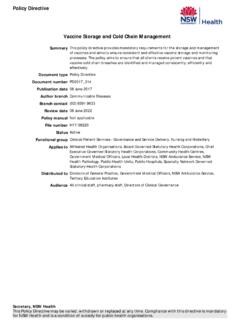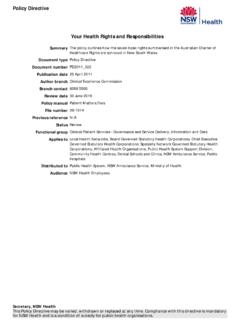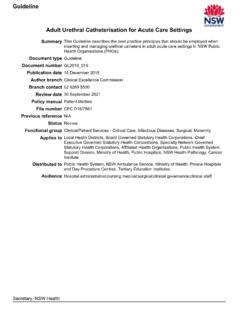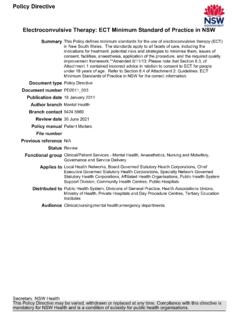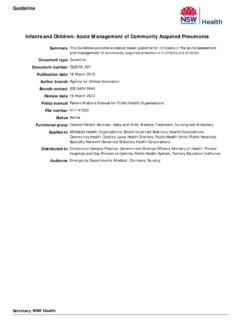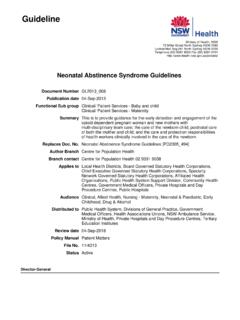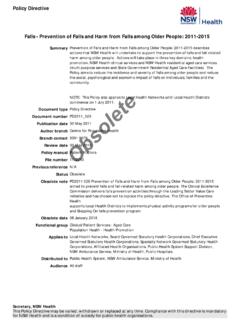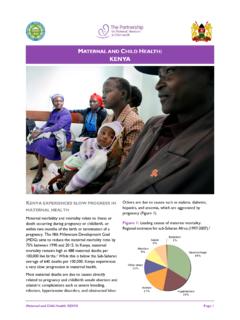Transcription of Maternity - Maternal Group B Streptococcus (GBS) and ...
1 Guideline Ministry of Health, NSW. 73 Miller Street North Sydney NSW 2060. Locked Mail Bag 961 North Sydney NSW 2059. Telephone (02) 9391 9000 Fax (02) 9391 9101. space space Maternity - Maternal Group B Streptococcus (GBS) and minimisation of neonatal early-onset GBS sepsis space Document Number GL2017_002. Publication date 17-Jan-2017. Functional Sub Group Clinical/ Patient Services - Maternity Clinical/ Patient Services - Baby and child Summary This Guideline provides guidance for two standard approaches used to identify women for whom intrapartum antibiotic prophylaxis should be offered, to reduce the risk of intrapartum transmission of Group B. Streptococcus (GBS) to the neonate and minimise the risk of early-onset neonatal GBS sepsis, Replaces Doc. No. Maternity - Maternal Group B Streptococcus (GBS) and Minimisation of Neonatal Early-Onset GBS Sepsis [GL2016_021]. Author Branch Health and Social Policy Branch contact Health and Social Policy Branch 02 94617174.
2 Applies to Local Health Districts, Board Governed Statutory Health Corporations, Specialty Network Governed Statutory Health Corporations, Affiliated Health Organisations, Community Health Centres, Government Medical Officers, Ministry of Health, Private Hospitals and Day Procedure Centres, Public Health Units, Public Hospitals, NSW Health Pathology Audience Obstetricians, Midwives, Nurses, Neonatologists, Paediatricians, Emergency Department, GPs. Distributed to Public Health System, Divisions of General Practice, Government Medical Officers, Health Associations Unions, NSW Ambulance Service, Ministry of Health, Private Hospitals and Day Procedure Centres, Tertiary Education Institutes Review date 17-Jan-2022. Policy Manual Not applicable File No. H16/100803. Status Active Director-General GUIDELINE SUMMARY. Maternity - Maternal Group B Streptococcus (GBS) AND. THE MINIMISATION OF NEONATAL EARLY - ONSET GBS SEPSIS. PURPOSE. This Guideline provides guidance for two standard approaches used to identify women for whom intrapartum antibiotic prophylaxis (IAP) should be offered to reduce the risk of intrapartum transmission of Group B Streptococcus (GBS) to the neonate and minimise the risk of early-onset Group B Streptococcus (EOGBS) sepsis.
3 KEY PRINCIPLES. This Guideline provides Local Health Districts (LHD) with current, evidenced-based information to facilitate LHDs to ensure: Women are identified for whom intrapartum antibiotic prophylaxis (IAP) should be offered to reduce the risk of intrapartum transmission of GBS to the neonate and minimise the risk of EOGBS. Appropriate assessment, detection, and escalation of neonates at risk of, or exhibiting signs and symptoms of EOGBS which occurs in the first 0 - 7 days following birth The importance of information and support for Maternal choice is acknowledged. USE OF THE GUIDELINE. The Chief Executives of NSW LHDs are responsible to: Select either a routine antenatal culture-based approach or a risk factor-based approach Ensure the development and implementation of local protocols or operating procedures in line with the approach chosen across all Maternity facilities offering Maternity services Ensure the chosen approach is consistently applied and neonatal morbidity and mortality associated with EOGBS sepsis is monitored and reviewed as per NSW.
4 Health PD2011_076 Deaths - Review and Reporting of Perinatal Deaths and NSW Health Policy Directive PD2009_003 Maternity - Clinical Risk Management Program. REVISION HISTORY. Version Approved by Amendment notes January 2017 Deputy Secretary of Replaces GL2016_021. (GL2017_002) Strategy and Updated advice on treatment of GBS positive urine culture Resources Updated advice on discharge review of the well neonate >37 weeks gestation whose mother received antibiotic prophylaxis 4 hours before birth GL2017_002 Issue date: January-2017 Page 1 of 2. GUIDELINE SUMMARY. August 2016 Director of The Office Replaces GL2016_017. (GL2016_021) of Kids and Families Revisions to web links and references revised July 2016 Deputy Secretary, Replaces PD2005_240. Provides up to date evidence for (GL2016_017)) Strategy and screening for Group B Streptococcus in pregnancy and Resources guidance on clinical care for specific neonatal presentations and algorithms as quick reference guides for staff.
5 January 2005 Deputy Director- Circular 2002/28 released February 2002. (PD2005_240) General, Primary Issued as a policy in January 2005. Health and Community Partnerships ATTACHMENT. 1. Maternity - Maternal Group B Streptococcal (GBS) Screening and the Minimisation of Neonatal Early - Onset GBS Sepsis: Guideline. GL2017_002 Issue date: January-2017 Page 2 of 2. Maternity - Maternal Group B Streptococcus (GBS) and the Minimisation of Neonatal Early - Onset GBS Sepsis GUIDELINE. Issue date: January-2017. GL2017_002. Maternity - Maternal Group B Streptococcus (GBS) and the Minimisation of Neonatal Early - Onset GBS Sepsis GUIDELINE. CONTENTS. 1 BACKGROUND ..1. Scope ..1. Key Relevant NSW Health policy directives and guidelines ..2. 2 STANDARD APPROACHES ..2. Risk factor-based approach ..3. Routine antenatal culture-based approach ..3. Local Health District responsibilities ..4. 3 ANTENATAL CONSIDERATIONS ..5. 4 ELECTIVE CAESAREAN CONSIDERATIONS ..5. 5 INTRAPARTUM CONSIDERATIONS.
6 6. Vaginal disinfection ..7. 6 NEONATAL CONSIDERATIONS ..7. Signs and symptoms of neonatal Neonatal management ..8. Neonatal care 7 DISCHARGE 8 CLINICAL AUDIT ..12. 9 10 ABBREVIATIONS ..13. GL2017_002 Issue date: January-2017 Contents page Maternity - Maternal Group B Streptococcus (GBS) and the Minimisation of Neonatal Early - Onset GBS Sepsis GUIDELINE. 1 BACKGROUND. International consensus has not been reached on the best approach to the prevention of neonatal early-onset Group B Streptococcus (EOGBS)1. There is limited high level evidence to support a prescriptive approach to the adoption of either routine antenatal culture-based approach' or a risk factor-based approach'1. Either approach can be used to identify women who may have Group B Streptococcus (GBS) colonisation and for whom intrapartum antibiotic prophylaxis (IAP) should be offered to minimise intrapartum GBS transmission and the risk of neonatal EOGBS sepsis. Local Health Districts (LHDs).
7 Are encouraged to adopt either approach and ensure that it is well implemented1 and closely monitored. The application of either approach should acknowledge a woman's right to make an informed choice in relation to her care2. The overall incidence of EOGBS sepsis is approximately births and is the most frequent cause of severe sepsis in neonates during the first week of life3. A mortality rate of 4% to 6%, with confirmed GBS sepsis, is reported4. In 80% of cases that present with EOGBS sepsis, signs and symptoms in line with Signs and Symptoms of Neonatal Sepsis, will present in the first 6 hours while 90 - 97% of cases are evident within the first 24 hours of age (median 8 hours of age)3,4,5. The evidence suggests that more than 60%. of confirmed cases of neonatal EOGBS sepsis occur among neonates born to women who had a negative GBS culture at 35-37 weeks gestation4, which highlights the need to remain vigilant and to assess all neonates to identify signs and symptoms consistent with sepsis.
8 Maternal intravenous (IV) IAP has been shown to be the most reliable method of reducing the incidence of neonatal EOGBS3. However, the use of IAP has not been shown to significantly reduce the incidence of late onset GBS, neonatal mortality from GBS sepsis, or neonatal mortality from sepsis caused by bacteria other than GBS5. Strategies to minimise neonatal morbidity and mortality from neonatal EOGBS sepsis should begin before birth with the identification of women for whom IAP is indicated, and continue after birth with appropriate assessment, detection, and escalation of neonates at risk of, and / or exhibiting signs and symptoms of neonatal EOGBS sepsis. Scope This Guideline applies to all clinicians caring for antenatal and intrapartum women and neonates, regardless of the models of Maternity care and irrespective of the place of birth. GL2017_002 Issue date: January-2017. Page 1 of 13. Maternity - Maternal Group B Streptococcus (GBS) and the Minimisation of Neonatal Early - Onset GBS Sepsis GUIDELINE.
9 Key definition Early onset Group B streptococcal sepsis - refers to neonatal GBS sepsis that presents in the first 0-7 days of age5. Late onset Group B Streptococcus - refers to neonatal GBS sepsis that presents after 7 days and up to 3 months of age5. Intrapartum antibiotic prophylaxis - the intravenous administration of antibiotics following the onset of labour Should - indicates actions that ought to be followed unless there are justifiable and documented reasons for taking a different course of action Recommended - suggest (something) as a course of action. Relevant NSW Health policy directives and guidelines This Guideline should be read in conjunction with the following Policy Directives and Guidelines: Australian Health Ministers' Advisory Council 2014, Clinical Practice Guideline: Antenatal Care- Module 2, Australian Government Department of Health, Canberra PD2013_049 Recognition and Management of Patients who are Clinically Deteriorating Clinical Excellence Commission: Newborn Sepsis Pathway PD2005_406 Consent to Medical Treatment - Patient Information PD2010_022 Maternity - National Guidelines for Consultation and Referral PD2009_003 Maternity - Clinical Risk Management Program PD2011_076 Deaths - Review and Reporting of Perinatal Deaths GL2016_018 NSW Maternity and Neonatal Service capability Framework.
10 2 STANDARD APPROACHES. There are two standard approaches to the identification of women for whom IAP. should be offered to reduce the risk of intrapartum transmission of GBS to the neonate and minimise the risk of neonatal EOGBS sepsis in line with Section and Section The standard approaches to screening for GBS colonisation are a risk factor-based approach and routine antenatal culture-based approach. GL2017_002 Issue date: January-2017 Page 2 of 13. Maternity - Maternal Group B Streptococcus (GBS) and the Minimisation of Neonatal Early - Onset GBS Sepsis GUIDELINE. Risk factor-based approach A risk factor-based approach means that women are not routinely swabbed for GBS. colonisation during pregnancy but are assessed for risk factors which increase the risk of neonatal EOGBS sepsis4,6. Risk factors which increase the risk of neonatal EOGBS sepsis are: Previous GBS affected infant GBS bacteriuria at any time during the current pregnancy Preterm (<37+0 weeks) in established labour Maternal intrapartum pyrexia 38 C.

